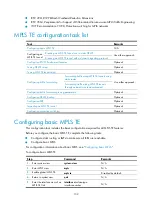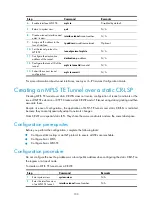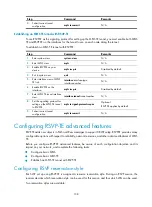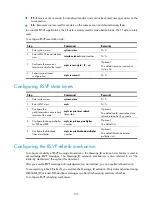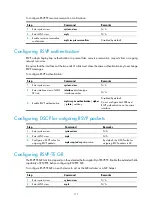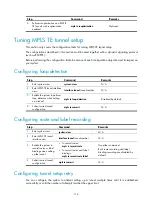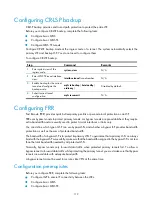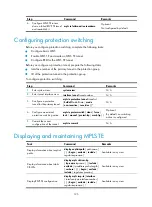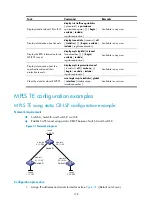
116
Step Command
Remarks
2.
Create a static route for
forwarding traffic along an
MPLS TE tunnel.
ip route-static
dest-address
{
mask
|
mask-length
}
interface-type
interface-number
[
gateway-address
] |
vpn-instance
d-vpn-instance-name
gateway-address
} [
preference
preference-value
] [
tag
tag-value
]
[
description
description-text
]
The
interface-type
argument must
be
tunnel
, and the preference
value must be set.
For more information about the
static routing configuration
command, see
Layer 3—IP Routing
Command Reference
.
Forwarding traffic along MPLS TE tunnels through automatic
route advertisement
Two approaches, IGP shortcut and forwarding adjacency, are available to automatic route
advertisement to advertise MPLS TE tunnel interface routes to IGPs, allowing traffic to be routed down
MPLS TE tunnels.
You can assign a metric, either absolute or relative, to TE tunnels for the purpose of path calculation in
either approach. If it is absolute, the metric is directly used for path calculation. If it is relative, the cost of
the corresponding IGP path must be added to the metric before it can be used for path calculation.
Enable OSPF or IS-IS on the tunnel interface of the MPLS TE tunnel before configuring automatic route
advertisement.
To use automatic route advertisement, you must specify the destination address of the TE tunnel as the LSR
ID of the peer and advertise the tunnel interface address to IGPs, such as OSPF and ISIS.
Configuring IGP shortcut
Step Command
Remarks
1.
Enter system view.
system-view
N/A
2.
Enter MPLS TE tunnel interface
view.
interface tunnel
tunnel-number
N/A
3.
Configure the IGP to take the
MPLS TE tunnels in up state
into account when performing
enhanced SPF calculation.
mpls te igp shortcut
[
isis
|
ospf
]
MPLS TE tunnels are not considered in
the enhanced SPF calculation of IGP.
If no IGP type is specified, the
configuration applies to both OSPF
and ISIS by default.
4.
Assign a metric to the MPLS TE
tunnel.
mpls te igp metric
{
absolute
|
relative
}
value
Optional.
The metrics of TE tunnels equal the
metrics of their corresponding IGP
routes by default.
5.
Submit current tunnel
configuration.
mpls te commit
N/A
6.
Exit to system view.
quit
N/A
7.
Enter OSPF view.
ospf
[
process-id
]
N/A
8.
Enable the IGP shortcut
function.
enable traffic-adjustment
Disabled by default.

